Concurrent elections closest to voter-turnout silver bullet

STV Cross Maltese Willingly Bear: While commentators are quick to blame low turnout on the single transferable vote system used to elect district health board members, Malta, which has used STV since 1921, boasts one of the world’s highest turnouts. Following World War II, while fewer and fewer New Zealanders voted, more and more Maltese did, although their turnout has trended down slightly since 1996. Earlier this year, Dr Joseph Muscat’s Labour Party trounced National, which had held power for 15 years. image Government of Malta
Another local body election, and another uninformed swipe at STV. While it is probable that the at-large, single-transferable-vote, district health board elections are the single biggest reason only a third of Aucklanders returned their ballots, the explanations for low local government election turnout, comparative to that for general elections, are far more fundamental.
Before single transferable voting was introduced, in 2004, it was voter apathy that was blamed for local government election turnouts being consistently lower. As for blaming postal voting, when it was introduced in 1992, postal voting successfully increasedvoter turnout. Now, it is probable that, at the very least, postal voting is slowing the decline in turnout. Declining voter turnout, however, since World War II, and in both central and local government elections, is a global phenomenon.
It is easy to overlook the historical perspective: The heyday of high voter turnout occurred relatively recently, in the 1930s and 1940s, and the history of modern democracies is surprisingly short. In England, even after the 1832 Great Reform Act, only about 10% of citizens were entitled to vote—one fifth of men, and no women at all. Up until that time, government had nothing to do with democracy—parliaments were about the sharing of power amongst the powerful. Having gained actual universal suffrage, as opposed to that which was formally known as universal suffrage, the kind that totally excluded women, it still took several generations before a healthy majority had developed the habit of voting. Despite New Zealanders’ justifiable pride, in 1893, in being the women’s suffrage world leaders, turnout in general elections didn’t reach its twin peaks of more than 90% until immediately before and after World War II. In sorry contrast, 2011 saw the lowest turnout figure in 120 years, of 74.2%. The age-eligible turnout was even lower: 68.2%.
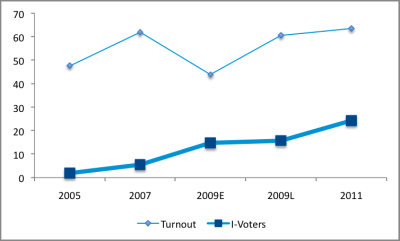
Twice the Estonian Turnout: Whereas Aotearoa might introduce online voting to address low local government election turnout, Estonia did it, in 2005, to help central government election turnout catch up with that of Estonian municipal elections. chart E-Voting.CC
Arresting, much less reversing, the downward trend will take both time and determined attention to the myriad reasons people decline to vote. Actual apathy is possibly the least significant factor, despite headline after headline categorising the record low 5 October local government election turnout as that. Three days later, for the worst of reasons, interest in the Auckland mayoral election reached fever pitch. Consequently, regardless of whether the next mayoral election is in three years, as scheduled, or much sooner as a result of further ruinous revelations about the misuse of mayoral power, it is guaranteed to exceed the woefully low 34% turnout—it could possibly be closer to the 2010 turnout, 50.2% of enrolled voters, which reflected the interest generated by the imposition of Auckland region’s new governance arrangements. Not that Auckland’s disgraced mayor will necessarily wear the butt of this revitalised voter interest, given the rapidly growing perception of the Palino camp eclipsing Brown–Chuang in the grubby behaviour stakes.
To his credit, the Minister Local of Government, Chris Tremain, is looking to fast-track plans to introduce online voting. The great virtue of going in this direction now, besides its utter inevitability, is that is will habituate many young people, and their children, into lifetimes of voting. And a great virtue of trialling online voting at local government level, as opposed to at a general election, is that if significant online electoral fraud occurred, the effects would be limited geographically. Having said that, it is unedifying that the Aotearoa, the world’s first full democracy, is languishing behind Estonia, which introduced online voting for general elections in 2005. On Sunday, Estonia implemented vote verification, going one step better than traditional paper-based systems, where voters must rely on trust that their vote has been counted.
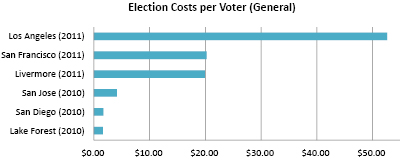
Win-Win for Local Government: Not only do concurrent elections slash electoral costs for municipal councils, but because central government elections bring out far more voters, more citizens get to vote for local government candidates, despite a degree of down-ballot voter drop-off. The elections displayed here that were held in 2010 were held concurrently with state and federal contests. chart Greenlining Institute
Concurrent elections
However, low local-government-election voter turnout cannot be effectively addressed in isolation. Heading the list of pragmatic measures available: Simply hold elections for central and local government concurrently. In California, driven largely by the need to curb local government expenditure, local election participation has been found to increase when municipal and state elections are held concurrently. This win-win could readily be implemented in Aotearoa, in time for the general election after next, 2017. It would require a one-off extension of the current local government term. Some might consider that being required to stay in office an extra year, before being dumped, a fitting punishment for Len Brown for his gross misuse of public office and property. The saving to ratepayers of concurrent elections would be considerable, and could conceivably completely offset the cost of introducing online voting, which in any event should be the responsibility of the electoral commission—it is an absurd anachronism that each council is responsible for its own electoral process. Auckland’s elections have just cost about $14.50 per person who cast a valid vote for a mayoral candidate. Contrast that with San Diego’s concurrent election in 2010, which cost that city only US$1.67 per voter.
Concurrent elections would also consummately address the increasing call to reintroduce a polling day and polling booths for local government elections. Concern that voter fatigue might set in before a voter reaches the local government section has proven to be misplaced—far more Californians make it to the end of lengthy concurrent ballot papers than otherwise make it to a polling booth, for separate municipal elections.

When Even Tamihere Trails: John Tamihere, despite being a household name, landed one ranking shy in his bid to be elected to the Waitematā District Health Board. Given that health board subdivisions were scrapped specifically to make it more likely that Māori representatives would be elected, that an urban Māori authority chief executive officer, radio talk-back host, and former member of Parliament failed to be elected shows by how far the measure has fallen short.
Along with synchronising local and central election cycles, voting methods need to be standardised. Some local bodies were brave enough, and sufficiently well informed, to embrace preference voting when it was made mandatory for district health board elections, and the option allowed for council elections, from 2004 onward. However, most councils have dragged the chain thus saddling their voters with a mixture of voting systems. If a hapless Aucklander, after ticking their preferred candidate for mayor and for council, and candidate or candidates for their local board, then proceeds to tick one or more district health board candidates, their possibly carefully made selection is deemed informal. The voter, in most cases, will be unaware that their voting, at least for the health board, has been in vain.
There is no moral or practical reason that voters should be required to rank health board candidates, as opposed to ticking those they wish to support. The system of counting and transferring voters’ preferences, as implemented in Aotearoa, could readily be adapted to accept either ticks or numbers, or a combination of both. The holy grail of voting systems, after all, is to faithfully capture the intention of as many eligible citizens as possible. For example, if a voter ranks three candidates 1, 2, 3, and gives a fourth a tick, the system should adjust the ‘errant’ tick to a 4. Further, if a number of candidates are ticked, the system should give equal weighting to each. The beauty of a good online system would be that, before a voter’s ballot is committed, the system would explain how the voter’s preferences were being interpreted, thus allowing the voter the opportunity to formalise their ballot.
A further benefit of online voting systems is that, by randomising the order of candidates, the effect of donkey voting is greatly diminished. Of course it is possible to individually randomise printed ballot papers, but it comes at a not insignificant cost, and as a result many councils shamefully opted to skimp—Auckland Council shaving about 2% off its $5 million electoral costs.

Halving Time in the Booths: For most of the 25 years that the Auckland Harbour Bridge was tolled, it was tolled in both directions, despite it being unviable for all but a handful of users to avoid making return trips. A similar saving of time in the booths could be made by holding local and central government elections concurrently. image Auckland Council Heritage Images
District health board ballots are daunting mostly because of the sheer number of candidates to be sifted through, reflecting the large single-electorate system. The reason that health board areas are not subdivided, as they once were, is that it was thought that a combination of preference voting (STV) and at-large electorates would result in better Māori representation. Māori representation, however, has failed to improve markedly, and every three years preference voting is ritually bagged for the high number of blank or informal votes, and failure of many to complete and return local government ballot papers.
Setting aside the knee-jerk response of calling for preference voting to be scrapped, there are two constructive options. The seemingly obvious would be to subdivide the at-large electorates, say along Auckland Council ward lines, which would result, in the case of Waitematā District Health Board, in four electorates each represented by two board members. The downside of this approach is that while geographic representation would be more even, it would inevitably come at some cost to ethnic and other minority representation. The healthiest solution is simply to allow ‘above the line’ voting, to enable voters, should they wish to vote along party lines, to select their party’s list. The beauty of a well-designed online system, is that voters, should they wish to, could use a party’s list to preselect candidates, while allowing the voter to exercise their right to alter list order, or mix and match from more than one parties’ lists.
While commentators often lazily conflate low voter turnout with apathy, many citizens refrain from voting in local government elections through lack of sufficient knowledge of the competencies or politics of the candidates standing. The Green Party’s success in Wellington powerfully illustrates the utility of party branding for local government candidates—all six candidates fielded by the party were elected or re-elected, including Wellington City Council Mayor Celia Wade-Brown. While the generally low opinion voters have of party politics is often well deserved, political parties serve an essential purpose in providing a degree of transparency to the networks that invariably exist behind politicians. So rather than attempting to limit party involvement in local government, which merely succeeds in driving the connections underground, the main political parties have a duty to develop transparent local government policies and field teams of plausible and well-vetted candidates. Had the National Party been upfront in its involvement in the contest for the mayoralty, Auckland might not have been subjected to the unsavoury machinations of a small group of nobodies answerable to no one. And had Len Brown been required to seek nomination as the Labour mayoral candidate, there is a chance that the party would have received warning that favours bestowed on a mistress were likely to compromise a further term in the country’s only mayoral office that enjoys significant executive power.
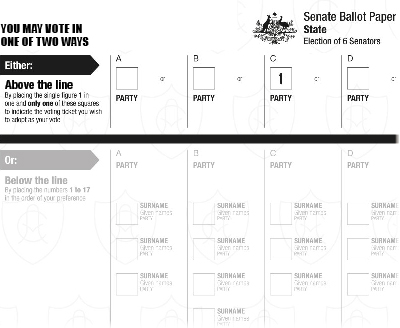
Addressing Downside of Above-the-Line: The surest way of incentivising political parties to field robust tickets of candidates in local elections is to provide the choice to citizens of above-the-line voting, as used in many countries including Australia for its federal Senate elections. A recognised downside of above-the-line voting, a lack of transparency as to how minor parties might have distributed their preferences, is easily addressed with online voting—when a party was chosen, the candidates invoked would immediately be revealed.
Given that about 18% of district health board ballots were returned invalid or blank, it is reasonable to assume a similar percentage didn’t make it into the post on account of voters finding the task of ranking seven candidates out of a field of 44, in the instance of Waitematā, far too challenging. As mentioned at the outset, preference voting, ranking rather than ticking, has again been blamed for low voter turnout. But before throwing the baby out with the bathwater, and provided that above-the-line voting is provided for, there are powerful, well established, reasons to standardise on preference voting. An example is where an existing popular local board member decides, at a subsequent election, to chance election as a ward member. For good reason, if successful, that candidate, even if she also polled sufficiently well there, cannot also be elected to the board—the whole purpose of the local boards is to increase local representation; the local board area would effectively loose one of its representatives. But this particular candidate, because of her success at the ward level, has just wasted the votes cast for her at the local board level. Those particular voters have been arbitrarily disenfranchised. This happened in 2010 in respect to Penny Webster, who stood for both local board and ward. This year it happened in three other local board areas. It is entirely reasonable that a candidate should be able to stand for ward and board, otherwise the risk of failing to be elected as a ward representative would be an undue disincentive to an incumbent local board member. Preference voting eliminates the anomaly, because the votes for the candidate withdrawn, that in first-past-the-post would be wasted, are transferred according to the voters’ subsequent preferences.
A more significant situation occurs where the elevation of a candidate involves a move from central to local government, as in the case of the successful bid by Member of Parliament Lianne Dalziel for the Christchurch mayoralty. Concurrent elections and preference voting would have neatly avoided the need for a $0.5 million by-election.
The other great quality of preference voting is its ability to resolve situations that would otherwise require additional and notoriously costly runoff elections to determine which of two strong candidates is actually preferred, once the also-rans are removed from the contest. Had John Palino picked off a further 17% of Len Brown supporters, which might well have happened had his mistress spilled a week earlier, the election would have been a virtual draw, but with the winner still short of an absolute majority. In many democracies, the result is decided by a runoff election, which allows those who voted for less popular candidates (70 659 people, in the case of the Auckland mayoralty) to refocus on the main two contenders. Aside from the extra expense and time involved, runoff elections are open to gaming.
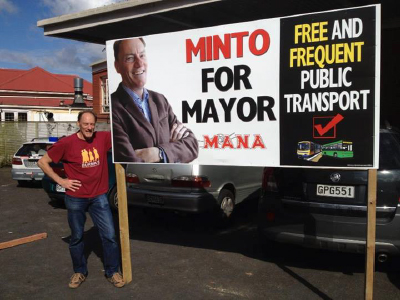
Should Have Voted for Minto: For a candidate, and foreigner, little-known to New Zealanders to come within 16 percentage points of becoming mayor of their largest city, illustrates how vulnerable their country’s democracy is to being bought by anybody with $1million throw at it. If the candidate, to be plausible, first had to win nomination from a registered political party, it would have provided some insurance against a person of completely unknown ethics to be in contention. More fundamentally, privately funded election campaigns must be outlawed. But what it says when a proven patriot standing for an established political party, and having the only transport plan that will make a blind bit of difference to the planet, polls only 3.3%, is another matter entirely. image The Daily Blog
As detailed in the Mahurangi Magazine’s MMP Review submission, a preference-voting overlay of the mixed member proportional would cure most of that system’s defects, aside from the coattails provision, which long since should have been abolished. The single most problematic aspect of mixed member proportional is that half those voting don’t understand that their electorate vote, except in manipulated circumstances, has no effect of the election outcome; the party vote is all. There is no affordable way in which a significant percentage voters’ understanding of this fact can be changed, as the lesson would have to be repeated ahead of each and every election. The solution is to invite voters to rank both electorate candidate and party. The benefits are threefold:
- The successful local-electorate candidate will be she whom is preferred by the largest number of voters—low-polling candidates, such as Green Party candidates, can’t split the vote.
- Votes cast for parties that fail to reach the 5% threshold are not wasted, but are transferred to those voters’ subsequent preferences for party.
- Central, local, health board, and licensing trust elections would have a standardised and simple voting method—rank the candidates or party 1, 2, 3 etc., or tick, if ranking is too taxing or goes against the habit of a lifetime.
Given Labour’s newfound belief in democracy, as demonstrated by its refreshingly transparent—and in the event, decisive—leadership election, which also featured preference voting, the party should waste no time in developing a comprehensive programme of local government electoral reform, with implementation paid for by the savings inherent in concurrent elections. In parallel to that work, the party should build its base by becoming far more strongly engaged in local government policy, city by city, ward by ward, local board by local board. By nurturing and supporting sound candidates to gain real-world experience serving their communities, including on school boards, and providing a pathway to becoming representatives on health and other statutory boards, and of parliament.
Despite Australians being forced to vote since 1925, their ditching compulsory voting is only slightly more likely than the possibility that New Zealanders will suddenly embrace it. There are myriad reasons why a person should not be compelled to vote, particularly when the only way to register an abstention is to return a blank or spoiled ballot paper. It is also a recognised recipe for donkey voting. Compulsory voter registration, however, might be considered, although surprisingly, a 10-year-old Canadian study found that compulsory voting, optional postal voting in advance or by proxy, and, to a lesser extent, proportional voting systems significantly benefited turnout, whereas compulsory registration didn’t. The finding that postal voting or voting by proxy—the ‘ease of voting’—positively benefited turnout should be taken as a strong indicator that online voting will prove beneficial.
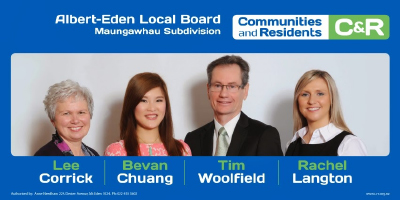
Three Out of Four: While National is no doubt extremely relieved that neither Bevan Chuang nor John Palino were official party candidates—Green and Labour, and National party candidates must currently run on City Vision or Communities and Residents tickets respectively—the three major parties, by staying at arm’s length from local government elections, are badly missing out on an important opportunity to build their bases and their brands. Chuang alone out of this quartet failed to be elected.
More concerning than the steadily declining turnout, is the rapid decline of party membership, in the same post-World War II period. Democracy is not possible without democratic parties. The Labour Party has recently awoken to this fact and has significantly increased its membership by involving members in its recent almost-democratic leadership election. It now needs to find the courage to go all the way and scrap the weighting system whereby one Member of Parliament’s vote is worth the combined votes of about 600 card-carrying members—the election of David Cunliffe was a minor miracle.
Topically, there appears to be a direct correlation between the declining turnout and voters’ respect for politicians, which Gallop found to be on a par with car salespeople, at the bottom of the table of professions considered—only lobbyists and telemarketers scored lower. But while the only 8% and 10% respectively who considered the honesty and ethical standards of car salespeople and Members of Congress to be high or very high is possibly unkind to both, it does contrast starkly with the 85% and 90% who happily ranked nurses and fire-fighters high/very high. Meantime, most were happy to shoot the messengers, with journalists and reporters doing only twice as well as Members of Congress—even chiropractors scored three times better than politicians. Speaking of things unscientific: Fluoride is found naturally in Waikato River water, but in levels too low to adequately prevent tooth decay. In June, Hamilton City Council was spooked into stopping fluoridation after receiving 1557 submissions, 89% of which were against fluoridation. The highpoint of the 2013 local government elections was the result of a referendum held concurrently wherein 70% backed the restoration of fluoridation. This was exactly the same level of support the city received for fluoridation in its 2006 referendum.
Fluoridation could be seen as a metaphor for the frustrating disconnect between local and central government that spawns disrespect for politicians, local and central. Fluoridation, like iodised salt, and more recently the addition of iodised salt to bread, is clearly a central government issue, or indeed a trans-Tasman issue. Devolving such crucial decisions to local government level is a misuse of the limited local representation resource available. There are innumerable other examples, but a particularly North Carolinian one leaves each city, district or regional council muddle through without the aid of a national environmental standard on sea-level rise. Again, political parties must play their part in evolving policies that span the local–central government divide.

World’s First Democracy: Although the United States was the first, extant, sovereign state to continuously elect its leaders, less than half its people were enfranchised, with all women and most blacks excluded. Although Aotearoa was the first country where the majority of adults were enfranchised to vote, its democracy is compromised by its reliance on a monarchy, admittedly a parliamentary monarchy, for the royal assent for laws past. If New Zealanders were to elect their Governor-General, expunge the last vestiges of first-past-the-post, and institute clean, publicly funded elections, their democracy would renew its claim to being world-leading.
Returning to the issue of trust. The unedifying spectacle of John Banks’ doomed attempt to defend the indefensible should be ample stimulus for a comprehensive examination of the virtues of public electoral funding. The one-to-one relationship that can be involved between electoral donations and favours is nakedly illustrated in Mr Dotcom’s statement to police that Hon John Banks had said:
I want to help you, Kim, and I can help you more effectively if no one knows about this donation.
Unsurprisingly, Judge Phil Gittos found that sufficient evidence had been presented to his court to commit Banks to trial for electoral fraud. Public electoral funding could be fiscally neutral. This is important because, while public funding is patently the only way elections can be clean, the public can be understandably averse to handing further funds to a profession perceived as already having its collective snout deep in the public trough. If future local and central elections were held concurrently, Auckland might be saved the best part of $4 million, which could fully fund clean campaigns for all elected council positions. Henceforth, the likes of casino owners would enjoy considerably less power over city officials.
Prior to 1893, ancient Athens included, there had only been partial democracies; Aotearoa was arguably the first, when, with the help of a few good men, its women won the right vote. It then took half century before more than 90% of those eligible had been taught the habit of voting. While it could take another half century, New Zealanders should aspire, by the sesquicentennial of women’s suffrage in 2043, to again have the world’s most advanced democracy, and have the highest non-compulsory voter turnout.
Political parties have much to gain by becoming fully involved in local government—the logical starting place is concurrent elections.

Many say not voting is a protest. Wrong! Not voting destroys democracy. In the 1960s the communists dominated the Public Service Association because they only had to round up a few dozen voters. Realising this, we rounded up about 50 people to vote for anyone else. That year we chucked them all out. You must vote for the people you believe in. Don’t vote for the no-hopers or those without skills. Having said that, I was very disappointed with the information provided by this election’s candidates. They stated what they saw as the problems but almost none of them said where they stood. They did not state their affiliations. In Warkworth the community paper subtly ran stories that were pitched to support business people and blacken the opposition. Guess who got in. It is easy to swing the vote when the turnout is low. Only vote for the good guys, and allow online voting. Democracy is important.